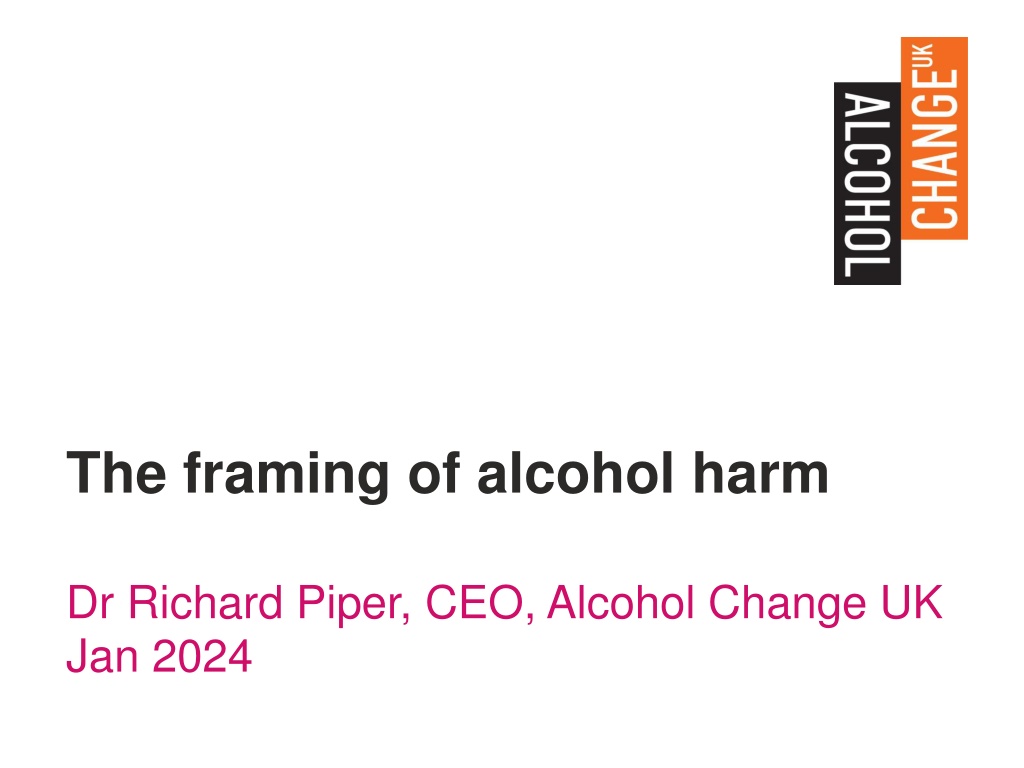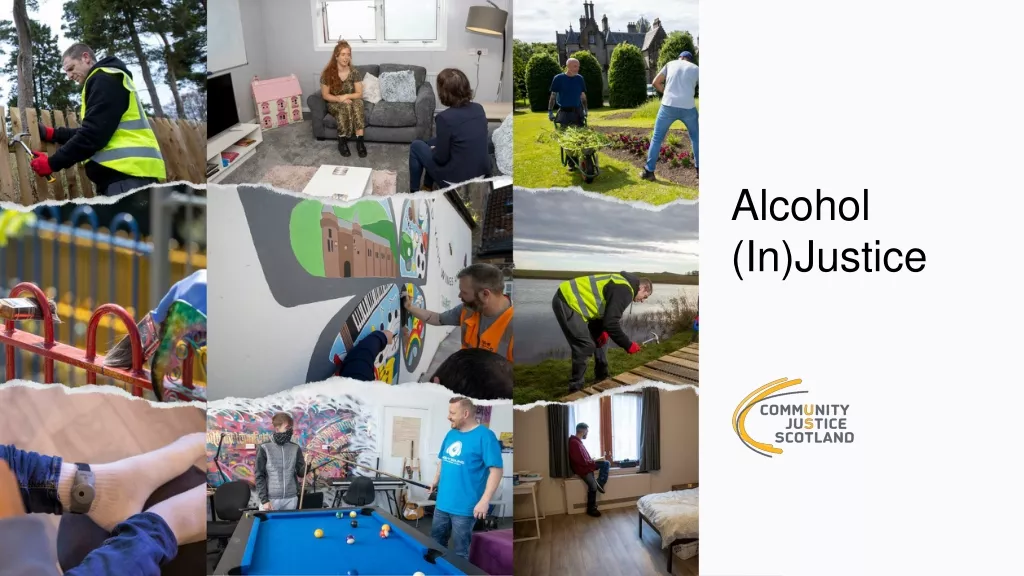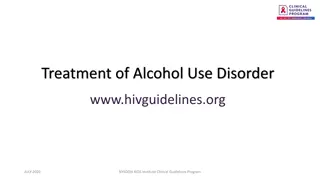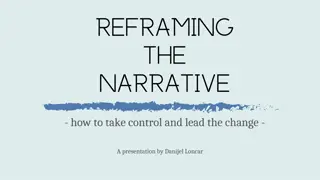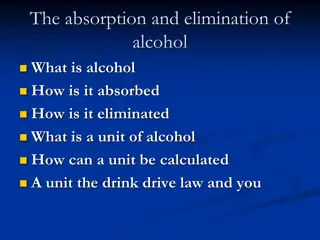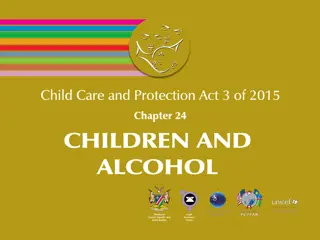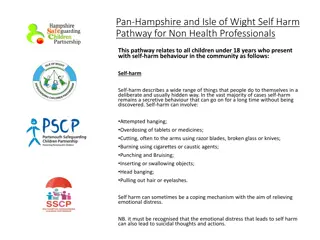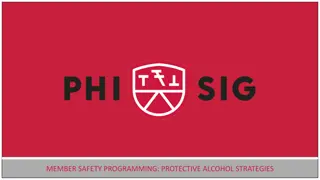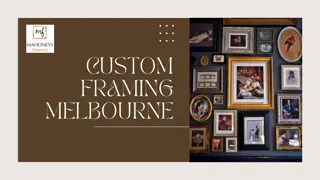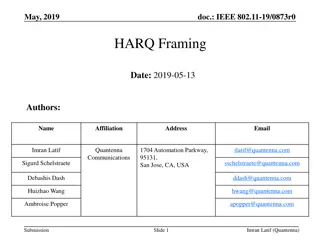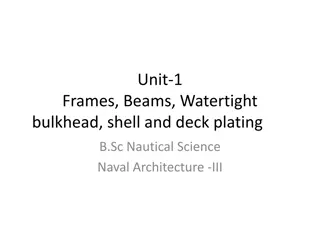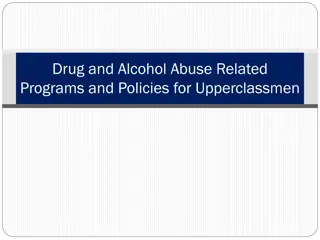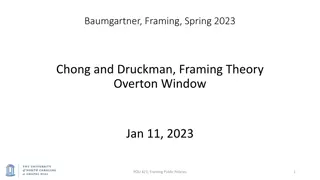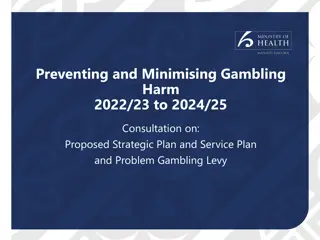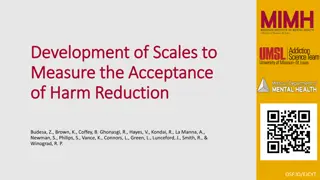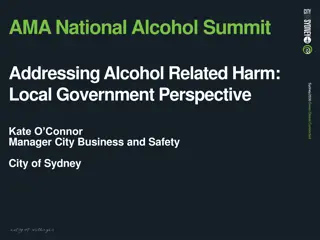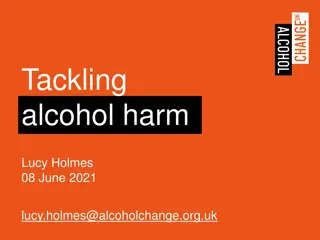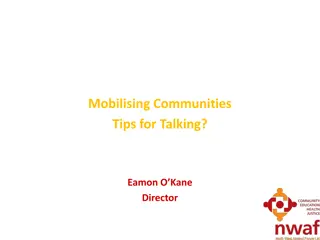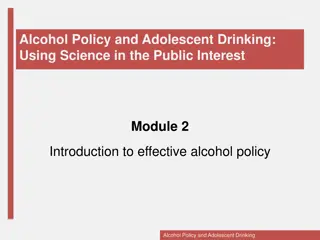Understanding Alcohol Harm Framing Project by Alcohol Change UK
Alcohol Change UK aims to reduce alcohol harm through research projects that explore public perceptions and alternative frames related to alcohol harm. By identifying current frames, testing alternative frames, and analyzing their impact, the organization works towards shifting public support for policy change to address alcohol-related issues effectively.
Download Presentation

Please find below an Image/Link to download the presentation.
The content on the website is provided AS IS for your information and personal use only. It may not be sold, licensed, or shared on other websites without obtaining consent from the author. Download presentation by click this link. If you encounter any issues during the download, it is possible that the publisher has removed the file from their server.
E N D
Presentation Transcript
The framing of alcohol harm Dr Richard Piper, CEO, Alcohol Change UK Jan 2024
What Ill cover 1. What is Alcohol Change UK? 2. What is our major Framing of alcohol harm project? 3. What frames did we test? 4. What are our findings?
What Ill cover 1. What is Alcohol Change UK? 2. What is our major Framing of alcohol harm project? 3. What frames did we test? 4. What are our findings?
About Alcohol Change UK Our vision: A world without alcohol harm Our mission: Reducing alcohol harm in the UK We are science-based, not ideological. We are against alcohol harm, not anti-alcohol. To reduce alcohol harm, five major, interlinked changes need to happen. Our strategy is to drive progress in all five areas simultaneously.
What Ill cover 1. What is Alcohol Change UK? 2. What is our major Framing of alcohol harm project? 3. What frames did we test? 4. What are our findings?
Alcohol Change UKs framing project Frames are ways of thinking about an issue The research project identifies: what frames the public (and indeed most politicians, journalists and professionals) currently hold about alcohol harm possible alternative frames which of these alternative frames actually work to shift public support for policy change (by thoroughly testing them)
Example current frame 1: Alcohol harm only means dependency (addiction, alcoholics ) This is the binary frame. Some people are seen as alcohol dependent, most people are not. A hard barrier between dependency and non- dependency is imagined. This has two effects. First, it emphasises the small minority of people affected, minimising the scale of the problem. Second, it implies something fundamentally different about people who are dependent, an othering that blames and shames (and kills). The real scale of the problem, and effective policy solutions (e.g. higher pricing, marketing controls), are undermined: This only affects a small proportion of the population. Why should we all be penalised?
Example current frame 2: Only drinkers experience harm This individualistic frame focuses solely on the drinker and ignores the world around them. To work, this frame has to totally ignore family members who are harmed by alcohol problems, as well as communities and wider society. This framing shrinks the scale of the problem. By portraying the only victims of alcohol harm as drinkers themselves, it also makes the highly judgemental only got themselves to blame argument. The real scale of the problem is undermined: This only affects a tiny proportion of the population and it only affects them, so why should we bother?
Example current frame 3:Alcohol harm is inevitable This fatalism frame builds on frame 1 and claims that some level of alcohol harm is natural in any society, because there will always be some people who misuse it . It uses the judgemental concept of misuse to reinforce the idea that alcohol problems are down to certain individuals, directly blaming the people who experience alcohol harm, even implying they are of less worth and not to be worried about. The frame only works if it ignores the huge differences in levels of alcohol harm between countries. Under this fatalistic frame, no policy solutions are needed: It ll always happen. Some people are just like that. What can we do about it?
Example current frame 4:We all have freedom of choice This frame says that people choose to drink alcohol freely. It claims that alcohol marketing (which makes us drink more) has no effect or rather, no effect on anyone strong-willed enough to ignore it. It s claim that this is about willpower reinforces the (deadly) shaming and blaming of frame 1. All responsibility from the state, industry, society and community is removed. Ineffective policy solutions are proposed: Well, they should just drink less! The state has no role. Effective policies are falsely dismissed: Limiting marketing will have no effect.
Example current frame 5:Alcohol is harmless and essential This frame is protective of alcohol as a substance. And this frame attacks anyone who speaks the truth about alcohol harm as being anti- alcohol . To work, this frame has to ignore the fact that alcohol is addictive and dangerous. It has to ignore all the health harms that occur even at low levels of consumption. It also ties alcohol to British identity (a clearly racist move) and pretends that drinking alcohol is essential to life, to fun, to relaxing, to socialising (which is complete nonsense). This frame attacks all policy solutions as extremist: It s the nanny state lot, the neo-temperance gang, trying to take away our precious alcohol.
Example future frame 1:Alcohol harm is on a spectrum This alternative frame directly challenges the binary frame above. It explains that alcohol harm occurs at low levels of drinking and includes mental health problems, strokes, and cancer not just addiction. Anyone can be affected by alcohol harm and indeed millions of us are. This avoids othering and reduces the blame and shame which kills people. It also makes the vital point that everyone who ends up as dependent started out as a non-drinker, and that there is a journey towards dependency. This makes the powerful case that early intervention can save lives and resources. The real scale of the problem is embraced: This affects so many of us. We need to act. And prevention beats cure.
Example future frame 2:We all experience alcohol harm This communalistic frame emphasises the experience of family members who are harmed by alcohol problems, as well as communities and wider society. This framing helps us see the real scale of the problem. By portraying us all as victims of alcohol harm, even if only as taxpayers, we see this as something we will all benefit from by solving. The real scale of the problem is embraced and calls for action grow: This affects all of us. I can t get into A&E, my taxes are going up, the courts are overflowing, I know so many people affected, we ve got to do something!
Example future frame 3:Alcohol harm is avoidable This frame is based on the fact that there is hardly any alcohol harm in many countries, rejecting the idea that this is natural or a part of the human condition . It also points to the fact that levels of alcohol harm within the UK have risen and fallen historically, based on policies. It is fluid, not fixed. It uses the concept of alcohol use to reinforce the idea that alcohol problems are strongly based on the role of alcohol in a society. Under this positive frame, policy solutions are not just needed but are desirable: We don t have to accept this. Alcohol harm can and does change. Let s reduce it!
Example future frame 4:All our choices are shaped This frame explains that the level of people s drinking is based significantly (not wholly) on their context. If alcohol is expensive, its availability restricted, and its marketing controlled, the entire country drinks less; and the number of people with drinking problems falls significantly. The frame undermines the idea that we all have total freedom of choice, while accepting that we are also not, also, total robots. It also notes that, if we believe in freedom, that should include freedom from exposure to alcohol marketing. Effective policy solutions are supported: We need to make alcohol more expensive, less widely available and less heavily marketed.
Example future frame 5:Alcohol is harmful but optional This frame tells the truth about alcohol. It accepts the right of anyone to drink it (avoiding the anti-alcohol label) while emphasising that it is addictive and dangerous. The choice to consume must always be made carefully. It disestablishes alcohol from Britishness by noting that many British Muslims, for example, disagree. It makes clear that drinking alcohol is always optional, never essential. This frame calls for alcohol policies that protect us from a powerful industry with private interests; an industry that pretends alcohol is essential to life: As citizens we want our Governments to put our health above any private interest. Alcohol is not just any commodity and Governments must protect us from its harm with smart, sensible policies.
Delivery partners This research is being delivered by: University of Stirling (lead) FrameWorksUK University College London University of Sheffield London South Bank University London School of Hygiene & Tropical Medicine It began in Sep 22 and completes in March 24
Project plan Desk research and focus groups 1. Public view of alcohol harm Expert workshop 2. Expert view of alcohol harm Brainstorm, based on public view work 3. Develop possible frames 16 x 90 minute focus groups with rigorous analysis 4. In-depth frame testing National survey of over 4,000 people looking at their movement on some key alcohol opinions after exposure to the frames 5. At-scale frame testing A practical toolkit outlining key recommendations and concepts 6. Develop framing toolkit A significant workstream to drive usage of the framings across our field 7. Promote & share toolkit
What Ill cover 1. What is Alcohol Change UK? 2. What is our major Framing of alcohol harm project? 3. What actual frames did we test? 4. What are our findings?
Frame 1. Truth value (1): The truth is that alcohol is not essential to anything Truth matters. But, right now, most of us don t know the truth about alcohol because it has become twisted over time. Many of us think about alcohol as being essential or central to socialising or relaxation or parties or celebrations. Big alcohol companies have spent billions on advertising and millions lobbying Government to keep us in the dark about the harms of alcohol, on fancy adverts to tell us we should reward ourselves with alcohol, and to promote the idea that we are not properly celebrating or socialising unless we re drinking alcohol. We rarely question this but somehow we ve lost sight of the truth that we can enjoy all of those things with less or no alcohol. When we put alcohol at the centre of those occasions, we can easily lose sight of what s truly essential: being with people we have fun with, people we love, looking after ourselves, feeling able to really be ourselves.
Frame 2. Truth value (2): There are more harms from alcohol, of many different kinds, than we are told It s important that we are told the truth about the products that are sold to us. Much of what we think we know about alcohol, is not actually true, and the reality is hidden from us. Drinking red wine is not good for our health, and the harms from alcohol go far beyond dependence and liver disease. But this is not what we are told in the media, on alcohol labels, or by the companies selling alcohol. Many of us think that alcohol is only harmful for other people, who drink more than we do. The truth is that for all of us who drink, cutting down would reduce our risk of cancer. Most people who cut down on alcohol sleep better, lose weight, have more energy and generally feel better. Yet most alcohol products don t have ingredients or calories on the labels, and companies spend millions lobbying to keep it that way. Alcohol adverts have multi-million pound budgets to link drinking to friendship, sports and glamour. In reality, alcohol causes anxiety and depression but we re not told that. It s time we were told the truth so we can choose for ourselves.
Frame 3. Change is possible value: We can reduce harms from alcohol and enjoy life In Britain, we haven t always drunk as much alcohol as we do now and we don t have to drink this much in future. Before the past few decades, we drank a lot less alcohol, and less often, than we do now. We don t have to have so many people getting illnesses like high blood pressure and cancer from alcohol, having their lives cut short. We can have fewer people hurt, annoyed, or worried by someone else s drinking. We can also have fewer hangovers, sluggish days or missed evenings. We know how to fix this. We can change how we talk about alcohol to get a better balance. We can make alcohol less central to our lives and society. We can better manage how and where and when alcohol is promoted and sold, to make it easier to cut down or not drink, when we want to. We can do all this without changing who we are or how much we enjoy our lives.
Frame 4. Fairness (People before profit) value: Its not fair that people suffer to make profit for big alcohol companies People shouldn t suffer to make profit for big companies. Unlike other companies, the profits of alcohol companies come at a high price for their customers. The product they are selling is a toxic, gradually addictive drug. Companies spend millions on slick adverts and sponsorship deals to sell the idea of alcohol as a rewarding, fun or glamourous drink. They encourage and remind us to drink alcohol on every possible occasion. These companies need lots of us drinking at levels that are harming us to keep their profits high. They need us drinking at levels that lead to more ambulance call- outs, longer waits at A&E, and more crime in homes and on the streets. They need us ruining our sleep, risking our health, and messing up our mornings. The companies know this, but it would be bad for business to admit it. Instead, they spend vast sums of money making us think that all alcohol problems are the fault of irresponsible people, not irresponsible companies. They lobby politicians to continue to be allowed to regulate their own advertising and to be able to sell alcohol in more places and around the clock. It s not fair that they are allowed to do all this to keep their profits high, no matter what harm comes to the people who drink the products they sell.
Frame 5. Freedom (of choice) value: People should be free to make choices about alcohol without expectations/pressure from anyone else People should be free to choose when they want to drink alcohol and when they don t, but it often doesn t feel that way. Alcohol is everywhere. We constantly see messages and pictures that suggest we need alcohol to really celebrate, relax and have fun. We re told that drinking alcohol must be part of every occasion from parties and weddings, to hotel stays and hairdressers, or even simple meals at home. This feels so familiar that we rarely question it anymore it s as if most of us go along with the idea that drinking is normal or even essential, and that not drinking is somehow wrong. If someone says they re not drinking because they re driving, we say leave the car ; if they re just having a night off, its come on, have a drink . Alcohol is a toxic, carcinogenic, gradually addictive drug, but we have set up our society in a way that pushes it on everyone. We make it harder for people not to drink. That s not freedom. We can do better. People should be free to decide whether or not to drink alcohol without expectations from anyone else.
Frame 6. River metaphor:When we drink alcohol, its hard to stay safe in the shallows When we drink alcohol, it s hard to stay in the shallows. We re surrounded by advertising, special offers, and social pressures that tempt us to go deeper telling us to come on in, the alcohol s fine . One drink makes it harder not to have another, and it s easy to get caught in the current. The deeper you go, the harder it is to drag yourself out. The water gradually gets more dangerous, with hidden harms beneath the surface and strong currents. Some of us will manage to clamber out unscathed, but we all know friends or family who have been hurt or got out of their depth. We need to prevent this happening. We need clear warning signs, telling us of the dangers, before we get in. We need to stop alcohol adverts trying to persuade us to get in deeper. We need to stop the strong, super-cheap booze in every supermarket and corner shop that makes the current faster. And we need to look out for each other, helping each other have fun without getting smashed by the swell or being dragged out to sea.
Frame 7. Disguise metaphor: Alcohol is disguised as a ticket to happiness, hiding how harmful it truly is From greeting cards to billboards, on supermarket shelves and bars, from fancy packaging to clever adverts, sponsorship deals and drinks promotions, alcohol is disguised as the best ticket to relaxation and fun. Behind the fancy packaging, slick slogans, and promised pleasure lies a silent killer in disguise. The fancy branding disguises the reality that alcohol is a toxic, addictive drug called ethanol that affects our bodies and our brain. Alcohol plays a role in more than 60 medical conditions, including stomach, bowel and breast cancers, high blood pressure, anxiety and depression. It causes more deaths and illness in younger people (15-49 year olds) than smoking. Alcohol companies pay big money to attach their brands to the things we love, whether its football, music, or friendship, so that the love we feel for the things we treasure in life rubs off on their brands. They are selling us alcohol and disguising all the harms it causes because they don t want us to know the reality. We can quite happily make our own decisions about drinking alcohol or not, without allowing marketing to sell us a lie.
Frame 8. Centre stage metaphor: We can move alcohol away from centre stage without spoiling the show Alcohol too often takes centre stage. It is cleverly promoted as a hero at the heart of our lives. Family events, celebrations, friendships, meals, sport - alcohol is always expected, often seen as front and central to the whole experience. But alcohol isn t the true star in our lives get-togethers would be nothing without friends and loved ones; we don t need advertising hoardings to enjoy a football match; we can cheer life s wins without alcohol taking over the show. Too often alcohol is the diva that hoards the limelight, casting shade on what s really important to us. Too often it overstays its welcome, stealing our mornings or messing up our plans. We can move the spotlight away from alcohol without spoiling the show.
Frame 9. Spectrum of harm explanatory chain: Anyone who drinks alcohol can experience alcohol harms or problems Key Message: We often think that alcohol problems are only something that other people have. But in fact, there s no clear line we can draw between people with alcohol problems and anyone else who drinks alcohol. Explanation: When it comes to drinking alcohol, many of us draw lines that say my drinking is fine but their drinking is a problem . We do this to feel comfortable about our own choices, but really problems from alcohol can happen to anyone at any level of drinking. In terms of health problems, drinking very small amounts of alcohol is low risk, but still makes us more likely to get certain cancers. o Liver damage doesn t just happen in people who have serious alcohol problems. Liver damage builds up slowly over time, without signs or symptoms until the damage gets pretty bad. o When we get anxious or depressed, drinking alcohol usually make things worse, often without us realising. o We don t have to be drinking all the time to get high blood pressure from alcohol. o All of these problems affect our health and happiness and put pressure on our health services. Many of us experience other harms from alcohol that we don t think of as drinking problems . We drink more than we meant to. We sleep badly. We feel rubbish the morning after. We get nothing done that we had planned. Sometimes drinking causes tension with family or friends. Final Consequence: When we only notice the most severe alcohol problems and harms, it stops us recognising how we might all benefit from reducing how much we drink. It stops us asking the government to take effective action to reduce these harms that affect us all. Solution: We can manage alcohol better as a society: people need better information on labels and adverts, proper restrictions on advertising and marketing, and better help to change their own drinking. We can reduce the harms from alcohol to benefit us all.
Frame 10. Wider causes explanatory chain: The harms from alcohol come about for many reasons beyond individual choices or culture Key Message: The high levels of drinking and alcohol harms we experience in the UK have come about for many reasons that go far beyond our individual choices or culture. Explanation: Our choices and culture are hugely influenced by how we manage alcohol as a society how we allow alcohol to be marketed and sold and how we talk about alcohol to each other. This environment strongly shapes our beliefs and attitudes towards drinking alcohol throughout our lives. o Global billion-dollar alcohol companies advertise drinking alcohol as a fun and harm free activity, and they lobby to keep selling cheap alcohol, wherever and whenever they can. o We are not told about the health harms from alcohol the anxiety, depression, sleep problems, high blood pressure, cancers, stomach ulcers etc. There s no mention of these on adverts or labels. o Most shops have alcohol on display, with attractive packaging and cheap deals calling to us to buy. o Young children see alcohol advertising, fancy packaging, and sponsorships giving them a one-sided view that alcohol is only ever positive, glamourous or fun. Many of us go along with these ideas. We rarely talk about the downsides of alcohol the hangovers, the family tensions, the lost days. We go along with the idea that only other people ever have alcohol problems . Because we have this one-sided view, we don t have good information to make choices. And of course alcohol itself affects our brains, making it harder to resist another drink and undermining our decisions. We all like to believe that we are making our own free choices, but in reality when alcohol is heavily promoted, more easily available and at cheaper prices, we buy and drink more of it. And when we do try to cut down or stop drinking, seeing alcohol advertised and available everywhere makes it even harder! Consequence: Alcohol problems are not just caused by someone s genes or their own choices. The society we have developed is saturated in alcohol: we need to recognise how that pushes us towards drinking more and more until some of us can t stop by ourselves. Solution: We need to stop blaming people whose drinking causes them problems and start asking the government to take effective action to change the environment: less promotion, reliable information on labels and adverts, and proper support services so that we all have what we need to reduce the harms from alcohol.
Frame 11. Diverse harms explanatory chain: Alcohol causes a wider range of harms than we often recognise Key Message: There are a whole range of significant and serious harms caused by alcohol across society but these are often not recognised. Explanation: Even small amounts of alcohol pose a risk to our health. As we drink more alcohol, or consume it more often, our physical and mental health risks also increase including from cancers, high blood pressure, stomach problems, anxiety, depression and difficulties sleeping. The harms from alcohol are not just to drinkers. We are all affected by how much alcohol is drunk in this country, but we often don t see these harms. Our health and emergency services are under pressure dealing with more alcohol-related illnesses as well as people who are drunk and aggressive; so we wait longer for treatment. Our communities are harmed when drinking spills over into anti-social behaviour, violence, and car crashes. When someone who drinks alcohol at high levels is part of our family, we can also experience a range of problems.We may worry about them, find that they contribute less to the family, that they re not always fully present or can be unreliable. We re also more likely to suffer poverty or domestic violence. Even at lower amounts of alcohol, people miss work or are less productive because they re ill or hungover and others have to pick up the slack; or drinking causes tension in relationships. The more we drink, the more harms we experience: domestic violence, money problems, harm to children, unemployment and homelessness. Final consequence: There are so many harms from alcohol and together they make life/society worse for us all, affecting drinkers, families, friends, colleagues, and taking up a lot of time, effort, and money for services and communities. Solutions: To reduce the harms from alcohol we need to take effective action now to reduce how much we drink and provide quality support services for those of us who need help to cut down.
Frame 12. New science (cancer) explanatory chain: We now know that if we drink less alcohol, fewer people will suffer and die from cancer Key Message: In recent decades, we have learned a lot about how to prevent cancer. We now know that if we drink less alcohol, fewer people will get cancer. Explanation: Alcohol damages the cells in our bodies and changes hormone levels. These effects make us more likely to get certain cancers including breast, liver, mouth, throat and bowel cancer. Drinking alcohol does not mean that someone will definitely get cancer, but it makes it more likely. If you don't drink alcohol, your risk of getting cancer from alcohol is zero. The more alcohol each of us drinks, the bigger the chance we will get cancer from the very first drink. That s because more alcohol means more damage to our cells and bigger hormone changes. When it comes to cancer, it doesn t matter what kind of alcohol we drink (beer or wine or spirits) or how we spread out our alcohol over the week. Even a small reduction in how much alcohol we drink reduces our risk of getting cancer. Final consequence: Alcohol causes many cases of cancer including breast, liver and bower cancer. If we drink less as a population, more of us will live longer without being affected by cancer. Solutions: If we want more people to live longer lives with their loved ones, free from cancer, we need to take action now to reduce how much alcohol is consumed in the UK. Less advertising, better information and improved support for people are all effective ways to do this.
What Ill cover 1. What is Alcohol Change UK? 2. What is our major Framing of alcohol harm project? 3. What frames did we test? 4. What are our findings?
Frame findings The three most effective frames were: Frame 2. Truth value (2): There are more harms from alcohol, of many different kinds, than we are told Frame 8. Centre stage metaphor: We can move alcohol away from centre stage without spoiling the show Frame 10. Wider causes explanatory chain: The harms from alcohol come about for many reasons beyond individual choices or culture
General findings It is helpful to outline a range of health harms (Frames 2 and 11), but it is best to avoid including harms that people find difficult to relate to and associate with more extreme stereotypes of problem drinkers (alcohol-related crime, violence, poverty), as these can lead them to blame others. It is unhelpful to go into too much detail on cancer in ways that worry people especially content that implies a risk of cancer with every single drink (Frame 12). This can cause defensive processing which leads to people rejecting the message or reinforcing their view that this is all about better personal choices. It is important to downplay the addictive nature of alcohol and the risk of loss of control, as this leads to othering/focus on personal responsibility and reinforces addiction stereotypes.
Thank you! Questions? Comments? richard.piper@alcoholchange.org.uk
